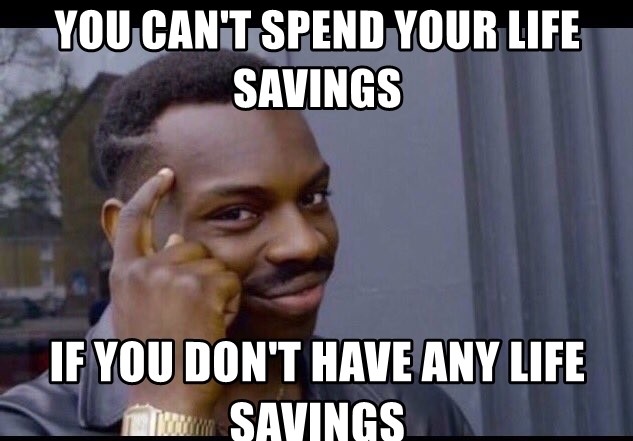In the last article we talked about earning money as the first step towards financial freedom. Assuming we have already done that, that is getting a job and more, we are now ready to proceed with the next step.
The next step would be to save as much as we reasonably can, to preserve the money we had earned. Only with a decent amount of money saved up, would using money to grow more money be actually practical. For example, John took out $100 for an investment and earned a return of 4% per year, bringing him a total of $4 at the end of the year. Tom took out $100,000 and had the same return, but he would achieve $4000 at the end of the year. Although both have the same percentage returns, but we know the difference it makes in terms of actual amount. Spending one week to do homework and researching on a particular investment and wait one year, only to get $4 is simply different from spending the same amount of effort, time and patience to earn $4000. Hence, saving your hard earned money is important. Only with a decent sized ball of money, will using it to roll more money be meaningful. That being said, when you have very little money, you can still do trading or investment. But at that stage your priority will be for gaining experience and learning lessons, not earning money.
As you can see from the title, this article will be focused on savings – an important and critical step in a list of steps towards financial freedom.
When I was young, someone advised me to save minimally 50% of my salary. The reason is that most of our golden career years will be very short. When we hit 40, many of us will go downhill from there, suffering from either retrenchments and/or pay cuts. By that time, even if we want to save, we may not be able to save as much. Coupled with all the debts and expenditure at that age such as housing loan, car loan (if necessary and applicable), child-rearing, family insurances etc, your spending will only go up, making it even more difficult to save. It took me some time to achieve the 50% savings rate but I manage to do so in the end and more, having expanded more income sources later on and increased my overall income. But as I kept my spending to a minimum, it meant that my percentage savings went up.
In my opinion, savings should have a long term, mid-term and short term goals.
Your short term goal should be to save up minimally 6 months worth of emergency savings. These 6 months emergency should tide you over for 6 months if you suddenly lose your job. Many people are hit hard by retrenchment because with the sudden loss of income, they do not have any money flowing in to pay their bills and daily expenses. More so, the lack of income caused many people not to be able to pay off their debt, eg housing debt and car loan, landing them into further trouble in times of distress. If you spend $4000 a month paying loans, maintaining daily expenses etc, then your emergency saving funds should be $4000 x 6 = $24,000. This will give you enough time while you are tiding over whatever crisis you are facing. Of course, the more you can save up, the better it is.
As a side information, the above is also one good example of why we should not have too much unhealthy loans as possible. Buying a house is fine, because you need somewhere to stay either way. But buying a house way over your ability to pay is unhealthy. The same for cars – buy only if you need. Some people get loans for everything, from a PC instalment to housing renovation loan, from credit card debts to futures leverage and margins in the financial markets.
Your mid-term goal would be something bigger, such as paying off your housing debt and saving up for your children’s future education expenses. I know in Western societies the kids get out and are independent from 18 onwards. While some societies in Asia such as Japan and half of Singapore also have children paying for their own university fees, there are many Asian parents who paid for their children’s university education too. Do not just restrict yourself to local university education. If an overseas opportunity is more suitable for your child and he or she could not go because of the lack of money, it would then be too late to regret for anything. While going overseas does not guarantee success and the benefits may outweigh the cost compared to a local education, but sometimes what we are buying is a ticket to a world of opportunities. Whether the child could make full use of the ticket or not is one thing, but if parents do not have the money to buy the ticket (when it is required), then perhaps it might cause a lifetime of regret. And who is to say that in Western cultures parents do not pay for their children’s expenses after 18? All those rich kids in school attending prestigious universities and spending loads of money, where do you think their money comes from? Flipping burgers or pumping petrol? The rich are all giving large amounts of money to their kids early on and supporting them on their journey, and us commoners can do the same too. While our money may not be big enough to be as impactful as the rich, we certainly could do something to help them meaningfully, even if they are at an age when they should be independent. Note that financially backing them meaningfully and spoiling them are 2 totally different things.
Your long term goal may be your retirement savings. How much do you plan to have when you retire? Is 1 million enough? Or 5 million? Whatever it is, that depends on what kind of lifestyle you want. Save more and you could enjoy more in retirement. Save too little and you might end up still at work at the age of 70. The whole range of lifestyle you can get is largely dependent on how much money you have saved up.
Savings should not be putting aside the leftover money from your spending so you can spend it in the future. Some say it should be about setting aside what you want to save first, then spend the remaining. That is something which I definitely agree to. Only by saving up first, then seeing the remaining amount which you can spend on, will you be able to spend more efficiently and effectively. In order to make sure you have enough to spend for the rest of the month, you will think through every purchase you make, whether you really need it or not, whether there is a cheaper alternative and so on. Of course, if you set the bar too low, such as saving 10% of your savings every month, then of course you will be able to hit your target easily, but your savings will grow at a very slow rate. Tracking your expenses is also a very good way to know what you spend on and in what areas you can cut down your spending on.
A savings plan should take into account your short, medium and long term goals. First set what each of your goals are, then work backwards. Look at how much you are earning now, and factoring in possible good things like pay increments and bonuses, potential bad things like retrenchments and inflations and major life events like marriage and children, you should have a skeletal plan of how much you need in the future and how much you need to save up. Of course the initial plan will be far from perfect, for we cannot predict the future well and we are inexperienced as we start out on this journey of savings. But as we go along we can and should improve and refine the plan.
Showing 1 - 3 out of 3
Page 1 out of 1
| - | Shop Products | Price | |
|---|---|---|---|
|
|
$99,999.00
|
||
|
|
$1.00
|
||
|
|
Price range: $69.00 through $99.00
|





